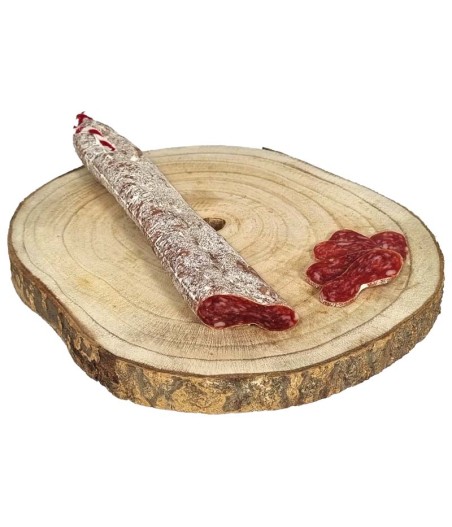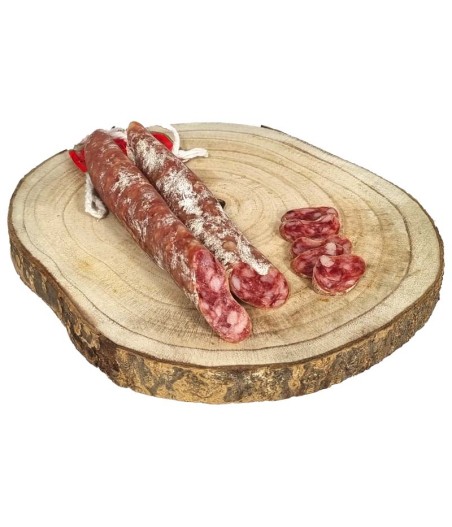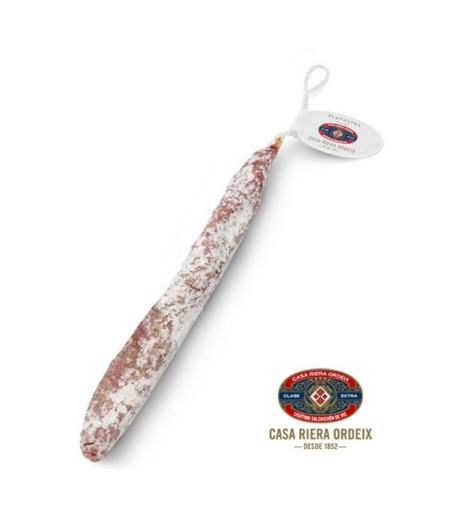Fuet de Vic, a great small sausage
Our fuets
Fuet is a typical Catalan sausage and today spread throughout Spain. We could say that all children have eaten a sandwich of this sausage at snack time. It is also in many weekend appetizers. Who hasn't gone to the kitchen and seen the fuet hanging and cut a couple of slices? Next, we will explain what makes this little sausage so special.
1. What is Fuet de Vic?
Fuet is a cured sausage that is eaten raw. For its preparation, are used lean and fat from the pig, seasoned with salt and spices and stuffed into natural casings about 3 centimeters thick and left to cure for about 3-4 weeks. Its most common shape is straight and about 30cm long, but we can find it in other shapes and thicknesses. It is characterized by the whitish color of the skin.
Where does the name come from? In Catalan, “fuet” means whip. The name comes from the sausage's resemblance to a whip, long and flexible.
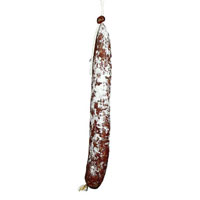
2. History of Fuet de Vic
To understand the history of fuet, we would have to go back 5,000 years. By accident, they discovered that by adding salt and spices to raw meat, they caused a spontaneous fermentation of meat bacteria that made the meat stable and dry and in good condition at room temperature.
We can say that the origin of fuet is in ancient Greece and Rome, where they discovered that by mixing the meat with salt, aromatic herbs, spices, and going through a drying or smoking process, they lengthened the life of the meat.
In Europe, during Roman times there is already evidence that the Iberians made sausages. This is linked to the climatic conditions of these countries as they needed long, sunny and dry days for drying the sausages.
The first sausages were surely made in the Pyrenees and then they spread. In Spain many sausages are produced, such as Salchichón, Chorizo and in some areas. In León, drying is done with smoke.
In medieval times, Catalan cookbooks mention sausages and pork derivatives, although there are no recipes on how to make them. From the Baroque, the monks mention sausages derived from pork in their recipe books.
In Catalonia, many sausages are made with special characteristics, surely with influences from other places. The most typical are the fuet and the longaniza.
The history of fuet will always be linked to Vic, although fuets are made in other parts of Catalonia. This Catalan municipality is the capital of the Osona region, located in Barcelona. This area is well-known for the production of sausages, especially Longaniza and fuet.
The Vic sausage was mentioned for the first time in a document from the 14th century. Afterwards, it became famous during the 19th century, when Alfonso XII came to the city and always visited the sausage factory, the first sausage factory in Catalonia. We could say that the fuet is the little brother of the salchichon
3. Elaboration of Fuet de Vic
Like the rest of the sausages, the fuet is made with raw lean pork and belly. Although fuet is currently made with other types of meat, such as turkey for example.
After chopping and mixing the lean meat and fat, they are marinated with salt and ground pepper. Other species may be added.
As in all cured foods, salt plays an important role. Salt inhibits microbial growth and the development of microorganisms may damage the meat. In addition to being a flavor enhancer and naturally enhancing it, salt acts as a natural preservative. This is fundamental for human development, since it has allowed food to be preserved for a longer time.
Normally, antioxidants such as sodium ascorbate and preservatives such as potassium nitrate are added. They contribute to giving it the typical color of curing. Finally, the mixture is stuffed into the natural casing of the pig's small intestine and left to cure in cold and dry spaces for approximately 3 weeks.
In the drying process, due to the humidity that comes out of the interior of the piece, a mold produced by the fungus Penicillium appears on the skin. This fungus is a natural protection of the skin that keeps the fuet safe from bacteria. This fungus is applied to the skin of the fuet on purpose during the drying process.
Now we just have to be patient and wait for the 3-4 weeks of drying to be able to eat the fuet!
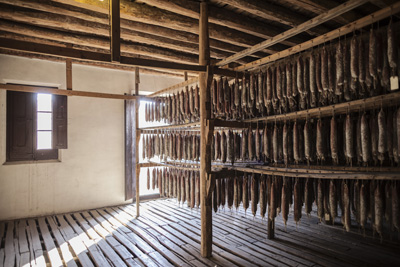
Our sausages
4. Types of fuet de Vic
Depending on the area of Catalonia or the caliber, we can find different names for fuet, and similar sausages with other names.
Starting from the same raw material and the same manufacturing process, we can find a very wide variety of sausages with different names depending on the caliber, the drying time or the added species.
Names: Fuet, secallona, espetec, somalla, tastet, cigala de gos, salsitxa, llamineta, llonganissa, canyetes, didalets…
Secallona and Sumaia are a little narrower in the center and longer than fuet. The percentage of fat may vary. The fact of being narrower makes the drying time shorter. Also, they don't usually have as much white mold on the outside.
The secallona usually has more pepper than the fuet.
The Tastet, was called as a test of the first fuet to see if the concentration of spices was correct.
The didalets or cigales de gos, are shorter and narrower fuets that are used as snacks or treats for children.
We can also find fuets in the shape of a horseshoe.
In terms of flavors, lately we find fuets covered with pepper, fine herbs, and paprika. There is also the achorized fuet, where red paprika is added.
In recent times, looking for other raw materials with lower caloric and fat intake, we can find turkey fuet.
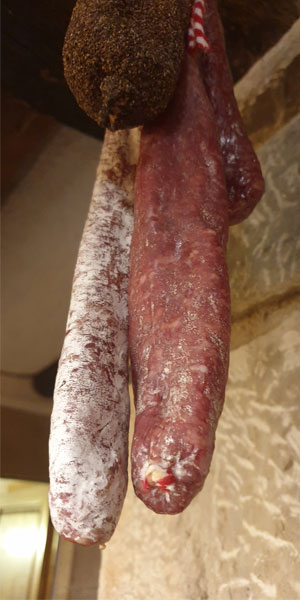
5. How to taste Fuet de Vic?
Is fuet eaten with or without skin?
The first question that arises is whether we eat it with or without skin. To answer this question, we have to assume that the skin that covers the fuet is a natural casing from the small intestine of the pig. This has been done throughout history, since the fuet has been an artisanal product.
Today, when fuets are made industrially, synthetic edible skins are sometimes used. If the fuet is made with natural casing, you can eat the skin without any problem.
We recommend you to try it with and without skin, since the whitish skin gives it different nuances to the flavor.
If the fuet is industrial and has a synthetic casing, take a good look at the label. It will say if it is edible or not.
Eat the fuet alone or accompanied?
To eat fuet, you only need a knife. Or not even that, there are those who eat it by mouthfuls! In many houses there is discussion about who has eaten the fuet. It has happened to all of us that we have the fuet hanging in the kitchen and every day it is shorter until it disappears. That's because fuet is something irresistible and when you're hungry and go into the kitchen you can't resist making some pieces. If you don't want to eat it alone, you can eat it with bread.
For breakfast or for a quick dinner, make yourself a slice of toast, spread with tomato, olive oil and cut into not too thick slices. You can also make a sandwich of fuet de vic, cut into thin slices, with bread with tomato and olive oil. It may be served as a lunch during your work break, as your children's breakfast or snack for school, or to take it on a picnic on a trip to the mountains.
If you cut it into slices, you can serve it as an appetizer, accompanied by some olives and some chips, while you drink a beer or a vermouth. You can also accompany it with some bread sticks at any time of the day as a snack.
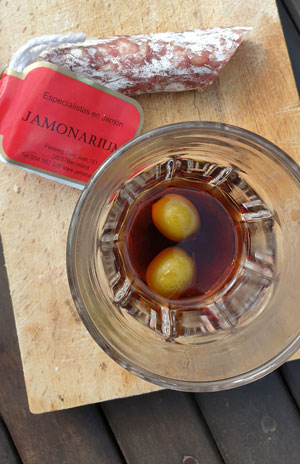
How to cut the fuet de Vic?
The best way to cut the fuet is on the bias, that is, a little diagonally and not perpendicularly. The slice will be longer and to present dishes it is more beautiful. The thickness of the slice will depend on the use that we are going to make of it. As an appetizer, we will cut the thickest slices, between approximately 0.5 and 1 cm thick. If we want to eat it as a sandwich, we may cut it into thin slices.
Depending on the curing of the fuet, we will cut thinner or thicker. If the fuet is more tender, it will be better to cut it into thicker slices, on the other hand, a more cured fuet will be cut into thinner slices.
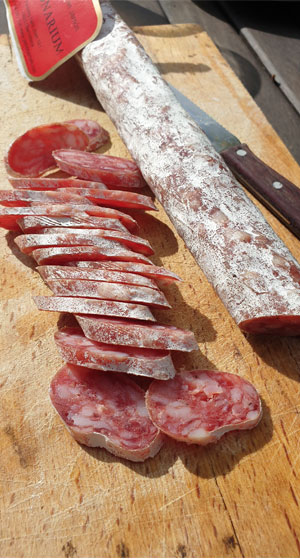
How to conserve the Fuet de Vic?
6. How to conserve the Fuet de Vic?
The best way to store sausages, and in this case the fuet de vic, is in a cool, dry and dark place. At home, the question we have is whether to put it in the fridge or not. Keep in mind that if we keep it out of the fridge it will dry faster. Being a fairly narrow sausage, it will dry very quickly and will soon become hard. We can put it in the fridge, so that it dries more slowly, but two things must be taken into account. First, remember to take it out of the fridge for a while before eating it, since when it is cold it does not have all its flavor. The second is not to wrap it with plastic or aluminum foil as moisture may appear.
It is best to have it covered with a fine cotton cloth or inside a closed container and wrap it with a little kitchen paper to absorb moisture.
Our sausages
7. Recipes with Fuet de Vic
Toast with Fuet de Vic
For this simple recipe we need some Pagès bread cut into slices, some hanging tomatoes (tomato spread), a good extra virgin olive oil and Fuet de Vic.
Toast the slices of bread, cut the tomato in half and rub it on one of the sides of the bread, until the whole bread is covered with tomato. We will add olive oil on top and place the Fuet de Vic cut into thin slices on top.
Fuet de Vic sandwich with tomato bread
For this sandwich, we need the same ingredients as for Vic's Fuet Toast. Only in this case we will use rustic baguette bread or bread with cereals. The procedure will be the same: Open the bread in half, spread the tomato on the inside of the bread and add olive oil to taste and the fuet cut into thin slices.
Fuet de Vic tartare
In this recipe, Maite from Antojoentucocina.com has reinvented and modernized the fuet toast with tomato bread. We leave you the link so you can see Fuet de Vic tartare recipe here.
Bikini sandwich with Fuet de Vic
Bikini is called the sandwich with ham and cheese sliced bread. This version consists of changing the ham for very thin slices of fuet.
Place two slices of sliced bread, a slice of Havarti cheese and very thin slices of fuet. On the outer faces of the bread, spread butter and toast it on both sides in the pan.
Salmorejo with Fuet de Vic
In this recipe we have merged a dish as Andalusian as Salmorejo, with a product as Catalan as Fuet de Vic.
Normally the Salmorejo is sprinkled with ham shavings. In this version, it is about cutting small pieces of fuet to put on top of the Salmorejo.
Couscous with Fuet de Vic and melon
In this recipe it is about having the contrast of the sweet melon with the salty flavor of fuet.
We cook couscous with vegetable broth and when it is ready, we add the melon in small cubes and the fuet also in small cubes. We dress it with olive oil and a little chopped mint to give freshness to this dish that is perfect for summer.
Make your own recipes with Fuet de Vic
Feel free to create your own recipes with Fuet de Vic. Fuet runs out quickly, but sometimes we have a piece that has remained dry and that can be used. You can chop it very fine and use it to season or decorate dishes. For example, put it on top of a fried egg, or a salad or add it to some macaroni with tomato.
8. The best selection of Fuet de Vic
Just as we have explained that there are several types of fuets. There are also many brands that make this product. Below we indicate some of the best known in Catalonia for their excellent quality.
Fuet Salgot
Fuet Can Duran
Fuet House Tarradellas
Fuet Obach
Fuet Casa Figols
Fuet Casademont
 4,9 / 5
4,9 / 5 





